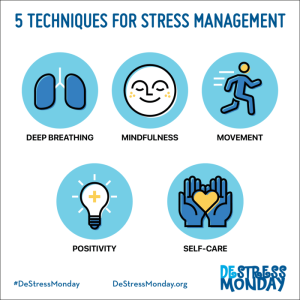Mental Health in the Workplace Statistics

Mental health in the workplace statistics reveal a concerning reality: a significant portion of the workforce struggles with mental health issues, impacting productivity, well-being, and the bottom line. This exploration delves into the prevalence of anxiety, depression, and other conditions, examining their correlation with workplace factors and exploring the economic consequences of inaction. We will also examine effective strategies for stress management, available support resources, and the crucial role of fostering a supportive workplace culture.
The data presented will highlight the disparities across industries, age groups, and genders, providing a comprehensive overview of the challenges faced. Furthermore, we will discuss practical steps individuals and organizations can take to promote mental well-being, from implementing mindfulness practices to creating robust support systems and policies.
Stress and Anxiety Management in the Workplace: Mental Health In The Workplace Statistics

Stress and anxiety are prevalent issues in today’s demanding work environments, significantly impacting employee well-being and productivity. Addressing these concerns requires a multifaceted approach encompassing individual coping mechanisms and supportive workplace initiatives. This section will explore practical strategies for stress and anxiety management, highlighting effective workplace programs, and comparing various stress reduction techniques.
A proactive approach to stress management is crucial for maintaining both individual and organizational well-being. By implementing effective strategies, employees can enhance their resilience and productivity, while organizations can foster a healthier and more supportive work environment.
A Practical Guide to Managing Stress and Anxiety
The following evidence-based techniques can help employees effectively manage stress and anxiety in the workplace. These methods focus on building resilience and promoting a sense of calm and control.
- Mindfulness Meditation: Regular practice, even for short periods (5-10 minutes), can significantly reduce stress and improve focus. This involves paying attention to the present moment without judgment, focusing on breath, body sensations, or sounds. Guided meditations are readily available through apps or online resources.
- Progressive Muscle Relaxation: This technique involves systematically tensing and releasing different muscle groups to relieve physical tension associated with stress. Starting with the toes and working upwards, this process promotes deep relaxation and reduces physiological stress responses.
- Deep Breathing Exercises: Slow, deep breaths activate the parasympathetic nervous system, counteracting the stress response. Techniques like box breathing (inhale for 4 counts, hold for 4, exhale for 4, hold for 4) can be practiced anytime, anywhere.
- Regular Physical Activity: Exercise is a highly effective stress reliever. Even moderate activity like a brisk walk during lunch or after work can significantly improve mood and reduce stress hormones.
- Time Management Techniques: Prioritizing tasks, setting realistic goals, and breaking down large projects into smaller, manageable steps can reduce feelings of overwhelm and improve productivity, thus lessening stress.
Effective Workplace Initiatives for Stress Reduction
Organizations play a vital role in creating supportive environments that promote employee well-being. Several initiatives have proven effective in reducing stress and enhancing mental health.
- Employee Assistance Programs (EAPs): EAPs offer confidential counseling, stress management workshops, and other resources to help employees address personal and work-related challenges.
- Wellness Programs: These programs often include health screenings, fitness challenges, health education sessions, and resources for stress management and mental health support.
- Flexible Work Arrangements: Options like telecommuting, flexible hours, and compressed workweeks can reduce commute stress and improve work-life balance.
- Mindfulness Training Workshops: Providing employees with training in mindfulness techniques can equip them with practical tools for managing stress and improving focus.
- Open Communication and Support: Fostering a culture of open communication where employees feel comfortable discussing mental health concerns and seeking support from supervisors and colleagues is crucial.
Comparison of Stress Management Techniques
Different stress management techniques vary in their effectiveness and suitability for individual needs. A combination of approaches is often most beneficial.
| Technique | Effectiveness | Limitations |
|---|---|---|
| Mindfulness Meditation | Highly effective for reducing stress, anxiety, and improving focus. | Requires consistent practice; may not be suitable for individuals with certain mental health conditions without professional guidance. |
| Progressive Muscle Relaxation | Effective for relieving physical tension and promoting relaxation. | Can be time-consuming; may not address underlying psychological causes of stress. |
| Deep Breathing Exercises | Quick and easy to implement; effective for immediate stress relief. | May not be sufficient for chronic or severe stress. |
| Regular Physical Activity | Highly effective for reducing stress, improving mood, and boosting overall well-being. | Requires commitment and may not be accessible to all individuals. |
| Time Management Techniques | Effective for reducing stress related to workload and deadlines. | Requires self-discipline and may not be applicable to all work situations. |
Mental Health Advocacy and Workplace Culture

Creating a supportive and understanding workplace environment regarding mental health is crucial for employee well-being and overall productivity. A proactive approach, encompassing mental health advocacy and a culture shift, is essential to address the stigma and promote open communication around mental health issues. This involves a multi-faceted strategy that includes the active involvement of mental health advocates, leadership commitment, and the implementation of supportive policies and practices.The role of mental health advocates within organizations is multifaceted and impactful.
Advocates act as a bridge between employees and the organization, providing resources, support, and a safe space for employees to discuss their mental health concerns without fear of judgment or reprisal. They actively promote awareness through workshops, training sessions, and the dissemination of information regarding mental health resources, both internal and external to the company. Furthermore, advocates work to challenge the stigma surrounding mental health, fostering a culture of empathy and understanding within the workplace.
Their presence helps create a normalized environment where seeking help is viewed as a sign of strength, not weakness.
The Role of Mental Health Advocates in Promoting Awareness and Reducing Stigma, Mental health in the workplace statistics
Mental health advocates play a critical role in normalizing conversations around mental well-being. They facilitate workshops and training sessions that educate employees on recognizing signs of mental health challenges in themselves and colleagues, promoting early intervention and support. They also work to dismantle harmful stereotypes and misconceptions surrounding mental illness, replacing them with accurate information and promoting understanding. A key aspect of their role is ensuring that mental health resources are readily available and accessible to all employees, regardless of their role or seniority.
This may involve creating a comprehensive internal resource directory or partnering with external mental health organizations to provide services. Furthermore, advocates can champion policies that support employees’ mental health needs, such as flexible work arrangements or generous leave policies. By acting as a consistent and visible presence, mental health advocates foster a culture of care and support, significantly impacting the workplace environment.
Strategies for Creating a Mentally Supportive Workplace Culture
Establishing a workplace culture that prioritizes mental health necessitates a multi-pronged approach. This involves leadership actively championing mental health initiatives, implementing policies that support employee well-being, and fostering open communication about mental health. Training programs for managers and supervisors are vital to equip them with the skills to identify and support employees experiencing mental health challenges. This includes recognizing signs of distress, conducting sensitive conversations, and referring employees to appropriate resources.
The creation of employee resource groups focused on mental health can provide a sense of community and support for those struggling. Implementing stress-reduction initiatives, such as mindfulness programs or wellness workshops, can proactively contribute to a healthier workplace environment. Regular communication from leadership about the importance of mental health, coupled with a commitment to providing the necessary support, is paramount in creating a culture where employees feel safe and supported.
Finally, anonymous surveys and feedback mechanisms can help assess the effectiveness of initiatives and identify areas for improvement.
Leadership’s Role in Fostering a Supportive Environment
Leadership plays a pivotal role in establishing a workplace culture that values mental health. Leaders must actively demonstrate their commitment to mental well-being by openly discussing their own experiences (where appropriate and comfortable), participating in mental health initiatives, and advocating for supportive policies. Their visible support normalizes conversations about mental health, creating a safe space for employees to share their concerns.
Leaders must also ensure that managers and supervisors are adequately trained to support employees struggling with mental health issues. This training should cover topics such as recognizing the signs of mental health challenges, conducting empathetic conversations, and referring employees to appropriate resources. Furthermore, leaders should champion policies that promote work-life balance, such as flexible work arrangements and generous leave policies.
By fostering a culture of open communication, empathy, and support, leaders can create a workplace where employees feel valued, respected, and empowered to prioritize their mental health.
Ultimately, addressing mental health in the workplace is not merely a matter of compassion; it’s a strategic imperative. By understanding the statistics, implementing effective interventions, and fostering a culture of support, organizations can create healthier, more productive, and more engaged work environments. The journey towards improved mental well-being requires a collaborative effort, involving employees, employers, and mental health professionals working together to create lasting positive change.
Answers to Common Questions
What are the most common mental health conditions affecting employees?
Anxiety and depression are among the most prevalent, but others like burnout, PTSD, and substance abuse disorders are also significant concerns.
How can employers measure the effectiveness of their mental health initiatives?
Track employee engagement, absenteeism rates, productivity levels, and employee feedback through surveys and focus groups. Consider using anonymous reporting mechanisms to encourage honest participation.
What legal obligations do employers have regarding employee mental health?
Legal obligations vary by location, but generally, employers are expected to provide a safe and inclusive workplace, offer reasonable accommodations for employees with disabilities (including mental health conditions), and maintain employee confidentiality.
How can I find a mental health professional in my area?
Your health insurance provider can offer referrals, or you can use online directories to search for therapists and counselors specializing in various approaches.





